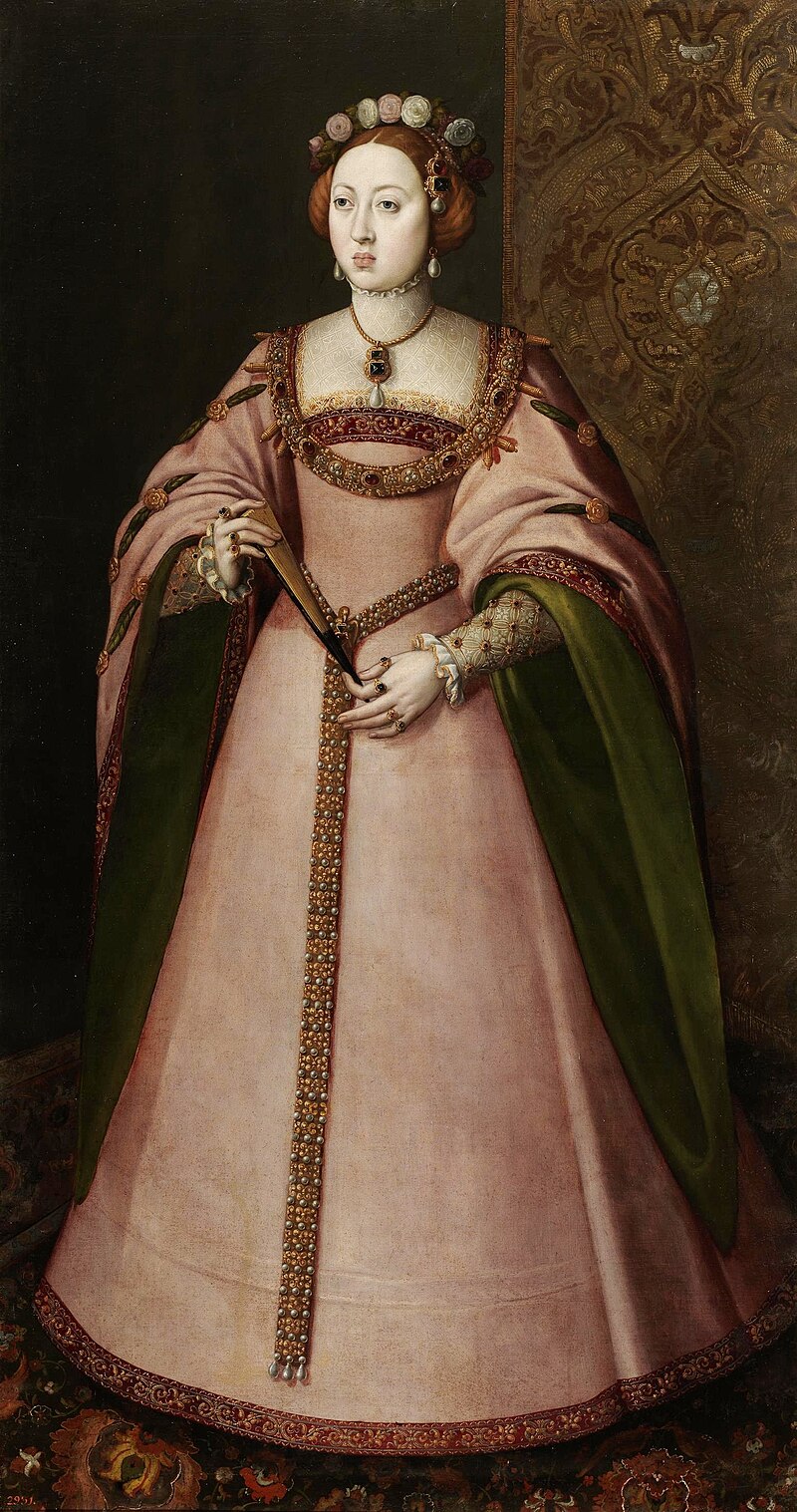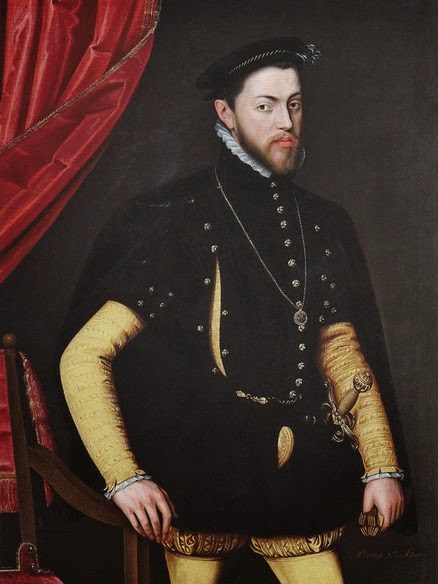by Susan Flantzer
© Unofficial Royalty 2022

Maria Manuela of Portugal, Princess of Asturias; Credit – Wikipedia
Maria Manuela of Portugal, Princess of Asturias was the first of the four wives of Felipe II, King of Spain but she died before he became king. Born in Coimbra, Portugal on October 15, 1527, she was the eldest of the three daughters and the second but the eldest surviving of the nine children of João III, King of Portugal and Catherine of Austria. Maria Manuela was the heir presumptive to the throne of Portugal from her birth until her brother Manuel was declared the heir in 1535. Maria Manuela’s paternal grandparents were Manuel I, King of Portugal and his second wife Maria of Aragon. Her maternal grandparents were Philip of Austria, Duke of Burgundy and Juana I, Queen of Castile and León and Queen of Aragon.

João Manuel, Maria Manuela’s only sibling who survived childhood; Credit – Wikipedia
Maria Manuela had eight siblings. Of her eight younger siblings, only João Manuel survived childhood but he died at age sixteen after producing a son who succeeded to the throne of Portugal.
- Afonso, Hereditary Prince of Portugal (born and died 1526), died in infancy
- Infanta Isabel (born and died 1528), died in infancy
- Infanta Beatriz (born and died 1530), died in infancy
- Manuel, Hereditary Prince of Portugal (1531 – 1537), died in childhood
- Filipe, Hereditary Prince of Portugal (1533 – 1539), died in childhood
- Infante Dinis (1535 – 1537), died in childhood
- João Manuel, Hereditary Prince of Portugal (1537 – 1554), married his first cousin Joanna of Austria, daughter of Charles V, Holy Roman Emperor, had one son who succeeded his grandfather João III, King of Portugal as Sebastian I, King of Portugal; João Manuel died from tuberculosis at age sixteen.
- Infante António (1539 – 1540), died in infancy

Felipe, Prince of Asturias, later King of Spain; Credit – Wikipedia
Maria Manuela’s upbringing was influenced by her mother’s deep religious piety and the expectation that as the only daughter of the King of Portugal, she would marry a high-ranking prince. Her groom was to be Felipe, Prince of Asturias (the title used by the heir apparent or heir presumptive to the throne of Spain), the eldest son and heir of Charles V, Holy Roman Emperor, King of Spain, Archduke of Austria, Lord of the Netherlands, Duke of Burgundy, one of the most powerful ever monarchs who had a large number of titles due to his vast inheritance of the Burgundian, Spanish, and Austrian realms. Maria Manuela and Felipe were double first cousins. Maria Manuela’s father João III, King of Portugal and Felipe’s mother Isabella of Portugal were siblings and Maria Manuela’s mother Catherine of Austria and Felipe’s father Charles V, Holy Roman Emperor were siblings.
The two sixteen-year-olds were to be married in Salamanca, Kingdom of Castile and León, now in Spain, and in October 1543, Maria Manuela left Portugal to travel to her new homeland. During her trip from Lisbon, Portugal, there were festivities at every stop. An incognito Prince Felipe followed Maria Manuela’s traveling party. When the royal party arrived at a town where they were going to rest, Felipe mixed with the crowds in the streets to watch his future wife.
Maria Manuela was met by the dignitaries of Salamanca and made a magnificent entrance into the city. Prince Felipe arranged to be on a balcony and Maria Manuela, aware that he would be on the balcony, covered her face with a fan as she passed by. However, the court jester distracted Maria Manuela with his jokes causing her to move the fan, revealing her face. Later that afternoon, Felipe left the Salamanca incognito, and then made a grand entrance into the city accompanied by Cardinal Juan Álvarez de Toledo and Fernando Álvarez de Toledo y Pimentel, 3rd Duke of Alba.
On November 15, 1543, the betrothal was celebrated at 1:00 AM with Cardinal Juan Álvarez de Toledo giving the couple the nuptial blessing. A nuptial mass was then celebrated at 4:00 AM. The rest of the day and several of the following days were spent in parties and tournaments. Maria Manuela and Felipe traveled to the Royal Convent of Santa Clara in Tordesillas, Kingdom of Castile and León to visit their mutual grandmother Juana I, Queen of Castile and León and Queen of Aragon. Juana was very pleased to see and embrace her grandchildren, and the story goes that she made them dance in her presence.

The tomb of Maria Manuela is on the right, the tomb of her son Carlos is on the left; Credit – www.findagrave.com
Sadly, Maria Manuela and Felipe had a short marriage. On July 8, 1545, Maria Manuela gave birth to a son in Valladolid, Kingdom of Castile and León. Four days later, on July 12, 1545, she died, aged seventeen, due to childbirth complications. Maria Manuela was initially buried in the Royal Chapel of Granada but in 1549 her remains were transferred to the Royal Crypt at the Royal Basilica of San Lorenzo de El Escorial in San Lorenzo de El Escorial, now in Spain, where she was interred in the Pantheon of Infantes which houses the tombs of Infantes, Infantas, and Queen Consorts who were not the mothers of a future King of Spain.

Maria Manuela and Felipe’s son Carlos, Prince of Asturias, circa 1562; Credit – Wikipedia
Maria Manuela and Felipe’s son Carlos, Prince of Asturias (1545 – 1568), died unmarried. Carlos was mentally unstable and was imprisoned in his rooms by his father Felipe in early 1568 after participating in a plot to murder his father. Carlos died, aged twenty-three, after six months of solitary confinement.
Felipe married three more times, to his first cousin once removed Queen Mary I of England, to Elisabeth of Valois, daughter of King Henri II of France and Catherine de’ Medici, and to his niece Anna of Austria, daughter of Maximilian II, Holy Roman Emperor, and Maria of Austria, who was Felipe’s sister. Felipe was a widower three more times and had children with his third and fourth wives. Having survived all four of his wives, Felipe II, King of Spain died at the age of 71 on September 13, 1598, and was buried in the Pantheon of the Kings at the Royal Basilica of San Lorenzo de El Escorial in San Lorenzo de El Escorial, Spain.
This article is the intellectual property of Unofficial Royalty and is NOT TO BE COPIED, EDITED, OR POSTED IN ANY FORM ON ANOTHER WEBSITE under any circumstances. It is permissible to use a link that directs to Unofficial Royalty.
Works Cited
- En.wikipedia.org. 2022. John III of Portugal – Wikipedia. [online] Available at: <https://en.wikipedia.org/wiki/John_III_of_Portugal> [Accessed 17 August 2022].
- En.wikipedia.org. 2022. Maria Manuela, Princess of Portugal – Wikipedia. [online] Available at: <https://en.wikipedia.org/wiki/Maria_Manuela,_Princess_of_Portugal> [Accessed 17 August 2022].
- Es.wikipedia.org. 2022. María Manuela de Portugal – Wikipedia, la enciclopedia libre. [online] Available at: <https://es.wikipedia.org/wiki/Mar%C3%ADa_Manuela_de_Portugal> [Accessed 17 August 2022].
- Flantzer, Susan, 2019. King Philip II of Spain. [online] Unofficial Royalty. Available at: <https://www.unofficialroyalty.com/king-philip-ii-of-spain/> [Accessed 17 August 2022].
- Louda, Jiri and Maclagan, Michael, 2002. Lines of Succession. London: Little, Brown.
- Pt.wikipedia.org. 2022. Maria Manuela de Portugal – Wikipédia, a enciclopédia livre. [online] Available at: <https://pt.wikipedia.org/wiki/Maria_Manuela_de_Portugal> [Accessed 17 August 2022].
